2017 浙江省舟山市中考英语真题及答案
考生须知:
1.本试题卷分卷I(选择题)和卷II(非选择题)两部分。请考生使用规定用笔,将所有试
题 的答案涂、写在答题纸上。做在试题卷上无效。
2.全卷共8 页,7 大题。满分为120 分。考试时间为100 分钟。
温馨提示:答题前请仔细阅读答题纸上的“注意事项”。
卷 I
注意:每小题选出答案后,用2B 铅笔把答题纸上对应题目的答案标号涂黑,如需改动,用
橡 皮擦干净后,再选涂其他答案标号。
一 、 听力(本题有15 小题;第一节每小题1 分,第二、三节每小题2 分;共计25 分)
第一节:听小对话,从A、B、C 三个选项中选出正确的选项,回答问题。
1. What is the weather like?
A. Sunny.
B. Rainy.
C. Cloudy.
2. What time does Sam get up on weekends?
A. At 8:00.
B. At 9:00.
C. At 10:00.
3. Where does David come from?
A. Canada.
B. Britain.
C. Australia.
4. How did Jack get to the cinema?
A. On foot.
B. By car.
C. By bus.
5. What will the man probably do this afternoon?
A. Go shopping.
B. Go swimming.
C. Go
fishing. 第二节:听长对话,从A、B、C 三个选项中选出正确的选项,
回答问题。 听下面一段较长对话,回答第6、7 两个问题。
6. What’s wrong with Linda?
�
A. She has a headache.
B. She has a cold.
C. She has a fever.
7. What’s the most possible relationship between the two speakers?
A. Father and daughter.
B. Teacher and student. C. Doctor and patient.
听下面一段较长对话,回答第8~10 三个问题。
8. What is Anna planning?
A. A study tour.
B. A school trip.
C. A family vacation.
9. How long will Anna stay in England?
A. For a week.
B. For two weeks.
C. For three weeks.
10. Why does Anna plan to go to Cambridge?
A. To visit her uncle.
B. To go sightseeing.
C. To visit a university.
第三节:听下面一段独白,从A、B、C 三个选项中选择正确的选项,回答问题。
11. What is Tom’s weekend job?
A. To print newspapers.
B. To sell newspapers.
C. To hand out newspapers.
12. Where does Tom put the newspapers on rainy days?
A. On the book shelves.
B. In the milk boxes.
C. In the letter boxes.
13. Why does Tom fix a light onto his bike?
A. Because he has poor eyesight.
B. Because he wants to make his bike nicer.
C. Because he often can’t finish the task until after dark.
14. How far is Tom’s working area?
A. Close to his school.
B. Close to his home.
C. Very far from his home.
15. Which word can best describe Tom?
A. Lazy.
B. Friendly.
C. Hard-working.
二、完形填空(本题有15 小题;每小题1 分;共计15 分) 阅读下面短文,掌握其大意,
然后从每题所给的A、B、C、D 四个选项中选出最佳选项。
It was the summer before my third grade. Our girls’
�
softball team was facing real pitchers( 投 球 手 )
16
the first time. Before that, we could just hit the ball
on the tee(球座). When the coach started pitching, hitting
became
17 for me. I missed every single pitch. From
the side, I heard my teammate Emily laughing at
18
. My face got hot and my throat
felt like it had a softball stuck in. At that moment, I was starting to
19
playing softball.
The next afternoon, when Mum said it was time to play the game, I told her
I was 20 . She allowed me to lie down for a while. So I went to my room and
21 myself in bed. This was difficult for me because I was fine and just
22
to avoid softball.
Soon Mum came in and said, “Time to go!” She didn’t even ask if I felt
23 . I imagined Emily laughing from the sideline, and
24
I really did feel
sick to my stomach. I began crying loudly. Still, Mum pulled my team T-shirt over
my head. She said, “You have to
25
for the rest of the season, and only
after that we can talk about
26
you’ll continue next year.” She added
that practice was what I needed, not
27
. She promised to practice with
me.
I got two hits that afternoon, and Emily didn’t make a 28 . Every week
after that, I practiced at home
29
I got to be one of the best hitters
on the team.
That
30
taught me being afraid is part of life, and I can do whatever
is expected of me if I keep working and practicing.
16. A. for
17. A. noisy
18. A. him
19. A. remember
20. A. bored
B. by
B. natural
B. them
B. hate
B. sick
C. from
C. hard
C. me
C. enjoy
C. shy
D. about
D. possible
D. us
D. practice
D. sad
�
21. A. helped
22. A. failed
23. A. safer
24. A. usually
25. A. play
26. A. what
27. A. waking up
28. A. plan
29. A. until
30. A. accident
B. dressed
C. threw
D. taught
B. wanted
C. refused
D. offered
B. better
C. warmer
D. happier
B. probably
C. carefully
D. suddenly
B. break
B. where
C. share
C. which
D. relax
D. whether
B. hurrying up
C. giving up
D. speaking up
B. sound
C. choice
D. decision
B. unless
C. after
D. though
B. business
C. relationship
D. experience
三、阅读理解(本题有15 小题;每小题2 分;共计30 分) 阅读下面四篇短
文,从每题所给的A、B、C、D 四个选项中选出最佳选项。
A
Come on! Get in Style!
Do you want to get some styling tips to look bright and pleasant?
31. The members of the Styling Club will meet every week.
Come and join us in the new Styling Club to make yourself different!
What will you learn?
A. one hour
C. three hours
B. two hours
D. four hours
B. The members will learn how to in the Styling Club.
★ basic haircare and skincare tips
★
★
make-up(化妆) and hair styling skills
proper mix-and-match skills
dressing tips for special occasions(场合)
C. dress properly
B. visit websites
C. make beautiful clothes
★
Stylist Ms. Janice Smith will teach members the above skills. Not only will you become more
confident with your look, you will also have the chance to help with the make-up and styling for
school activities like fashion shows and New Year’s parties.
When and where do we meet?
D. Kids who dream to be web designers
most probably join the Styling Club.
D. organize school activities
will
E. Teachers who expect to learn skin care
Our club meets every Tuesday after school, from 3:30 pm to 5:30 pm, at Room TA01 in the
F. Students who hope to look fashionable
Student Activity Centre.
How can you be a member?
G. Parents who wish to improve make-up skills
Students who want to join the club should visit our website at www.kts.edu.au/stylingclub to
B
sign up before 15th September. There are only 20 places. First come, first served!
What is the cost?
Around the world, there are about 7,000 National Parks. Most of them cover
huge areas of land where nobody lives. However, the National Parks in England
Each member needs to pay $50 for styling products.
How can you get more information?
For further information, you can email Karen Yung (karen.yung@kts.edu.au). She will be
happy to answer all your questions.
�
include places where people live and work, as well as wild areas where there are
few human activities.
The National Parks in England are called “England’s Breathing Spaces” because
they are places where people can go to be in the open air, away from the dirt
and noise of cities. They provide wonderful scenes of mountains, woods, grasslands
and wetlands. And there are plenty of activities to do in all of the National Parks
in England. Visitors can walk or ride bikes for fun. Many of the parks put on
activities for families.
Every year there are about 110 million visitors to the parks, bringing many
benefits(益处) to the
areas. At the same time, it creates problems too. First, life can be difficult
for local people. Car parks and roads are too crowded. Gift shops and cafes take
the place of many everyday shops. Even house prices in some areas can become too
high. Besides, country roads can be damaged, for too many people walk, cycle
or ride horses on them. Roads can be rebuilt, but then they look less natural.
Another big problem to the National Parks is litter. In the parks it is a danger
to wild animals. Broken glass can also cause fires by focusing the rays of the
sun. Such fires in wild places can be out of control.
▲ ? All National Parks in England are making more rules, which
tell people how to take good care of their environment. If these rules are followed,
the National Parks will be well kept and continue to give pleasure to many people
for a very long time.
32. Visitors to the National Parks in England can
.
A. give food to wild animals
B. drive cars on the grasslands
C. enjoy fresh air and peaceful time D. have fun farming with local people
33. The third paragraph mainly tells us .
A. the problems of the National Parks B. the pollution caused by visitors
C. the development of the National Parks D. the benefits brought by visitors
34. Which of the following is the best sentence to fill in the blank in Paragraph
�
4?
A. What can people get
B. How can people help
C. What are the National Parks like
D. How are the National Parks set up
35. The passage is probably taken from the part of a magazine.
A. transport
B. wildlife
C. history
D. geography
Have you ever been in a conflict(冲突)? Do you know how to solve it? Conflict
resolution is a peaceful way of trying to solve a conflict. Both sides in the
conflict explain what they think happened to cause it. The person who listens
to both sides is called the mediator(调解人).
After both sides tell what they think happened to cause the conflict, they
discuss ways to solve it. They try to come up with a “resolution” that both
sides agree to. They cannot be angry during the communication. Everyone should
use good listening and attending skills while talking. If voices get too loud
or it appears that someone is angry, the mediator will speak up and have them
treat each other with respect. After different suggestions are shared in how to
mediate the conflict, it is time for
discussing the best solution(解决办法).
Here is an example of how conflict resolution works step by step in a
school playground setting:
● Someone says a student pushed him on the football field.
● Thepersonwhowasaccusedasthe “pusher” saysitwasactuallyanaccident.
● The person who was pushed gets the mediator.
● The mediator takes the two persons to a quieter place, away from others to
talk.
● Themediatorcalmsthemdownandletsthemknowheunderstandstheirfeelings.
● Each person describes what happened.
● The mediator repeats what he heard, so it is clear to everyone.
● The mediator asks for ideas to solve the problem.
�
● The two persons offer their own solutions.
● The two persons have a discussion and come to an agreement.
● The mediator makes sure the persons follow the solution.
● The mediator offers praise for solving the problem.
Conflict resolution can be used in many environments. It encourages people
to tell what really happened, to share their feelings, and to work together
peacefully to solve the problem. It offers people workable steps to reach an
agreement with the help of a mediator.
36. According to the passage, if two students have had a fight, they had better
.
A. call the police
B. get a mediator
C. ask parents for ideas
D. describe the fight to teachers
37. In conflict resolution, the mediator’s job is to
.
A. describe what really happened to both sides
B. help both sides reach an agreement in a proper way
C. listen to both sides and then punish the trouble maker
D. write down what both sides have explained in the communication
38. The underlined words “was accused” in this passage might mean
“
” in Chinese. A. 被惩罚 B .
被轻视
C. 被指责
D. 被否定
39. The writer gives the example in the passage in order to .
A. show how a mediator works in a football match
B. help us know the importance of a mediator in daily life
C. show how conflict resolution is used in different environments
D. help us clearly understand the workable steps in conflict resolution
Kathy could still remember the night she had to leave her home in Hungary.
It was the beginning of World War II and her family had to leave their country
�
as soon as possible. She quickly filled a bag with a few pieces of clothing, her
diary, and her treasure—a beautiful silk scarf.
Kathy and her best friend, Monica, had asked their parents to buy them matching
scarves. They each would wear the scarves as a symbol of their friendship. Kathy
had no idea that she was going to America that night and would not be returning.
Kathy kept that special silk scarf for many years. One day she decided
to give it to her granddaughter, Eliza, to wear to her first job interview for
good luck. Kathy was afraid that Eliza would lose the scarf, but the granddaughter
promised, “Don’t worry, Grandma, nothing’s going to happen to your scarf.
You’ll see. It is going to bring both of us luck today.” And with that, Eliza
kissed her grandmother and left for the interview.
That afternoon Eliza left the interview, feeling sure that she had got the
job. So she decided to celebrate by going to a restaurant. As she was sitting
at her table, she felt someone looking at her. Sitting next to her was an old
woman, who could not take her eyes away from her.
“I’m sorry, do I know you?” Eliza asked.
“I’m sorry, dear, but you make me think of someone I once knew,” the old
woman replied. “My best friend looked like you and used to wear a scarf just
like the one you’re wearing around your neck.” Eliza listened carefully, with
her eyes and mouth wide open. She had heard stories of her grandmother’s best
friend and knew the meaning of the scarf. Could this be Monica, her grandmother’
s childhood friend?
Eliza introduced herself and waited to hear the name of the other woman.
“My name’s Monica, dear. I lived in Hungary as a child, but my family had
to leave when I was fourteen years old. I’ve been living here in California ever
since.” said the old woman.
Eliza could not believe her ears …
40. Kathy and her family left their country because _.
A. Kathy found a job in the USA
B. Kathy would study in California
�
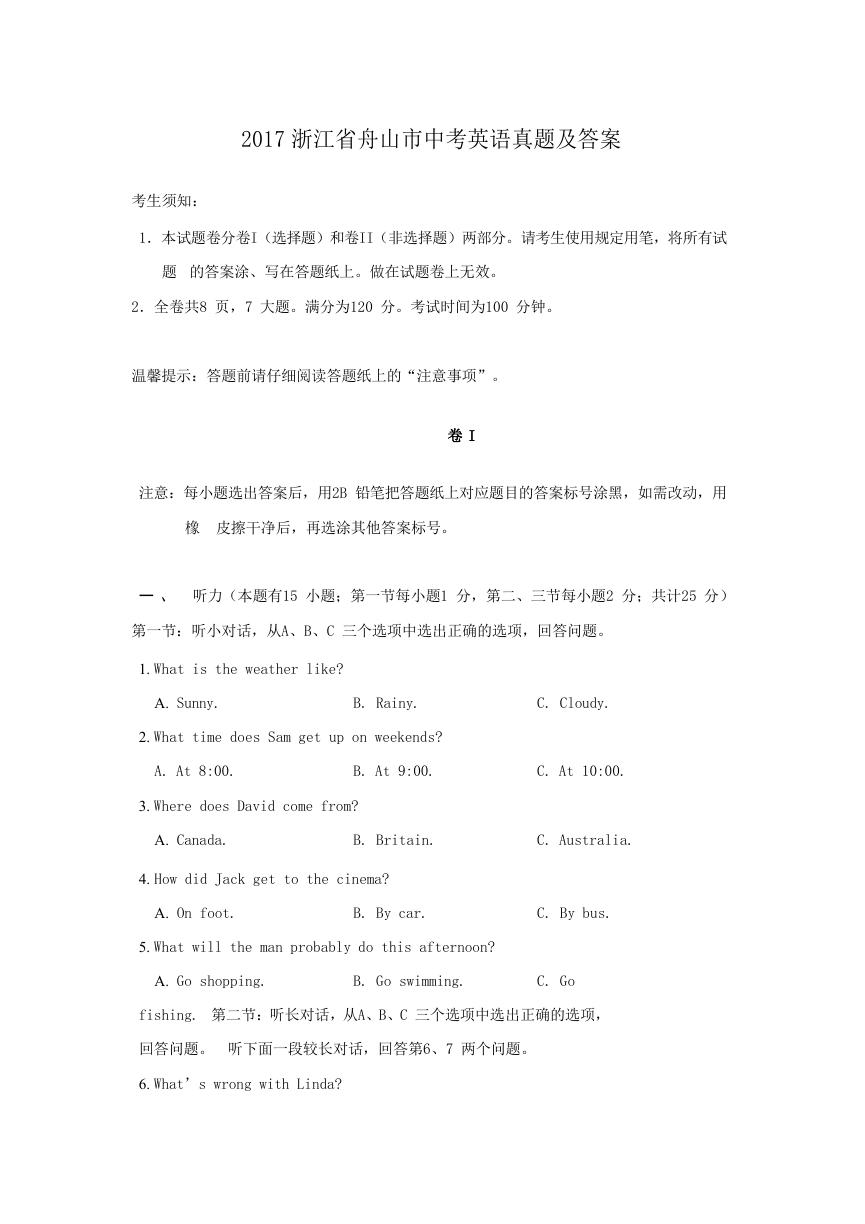



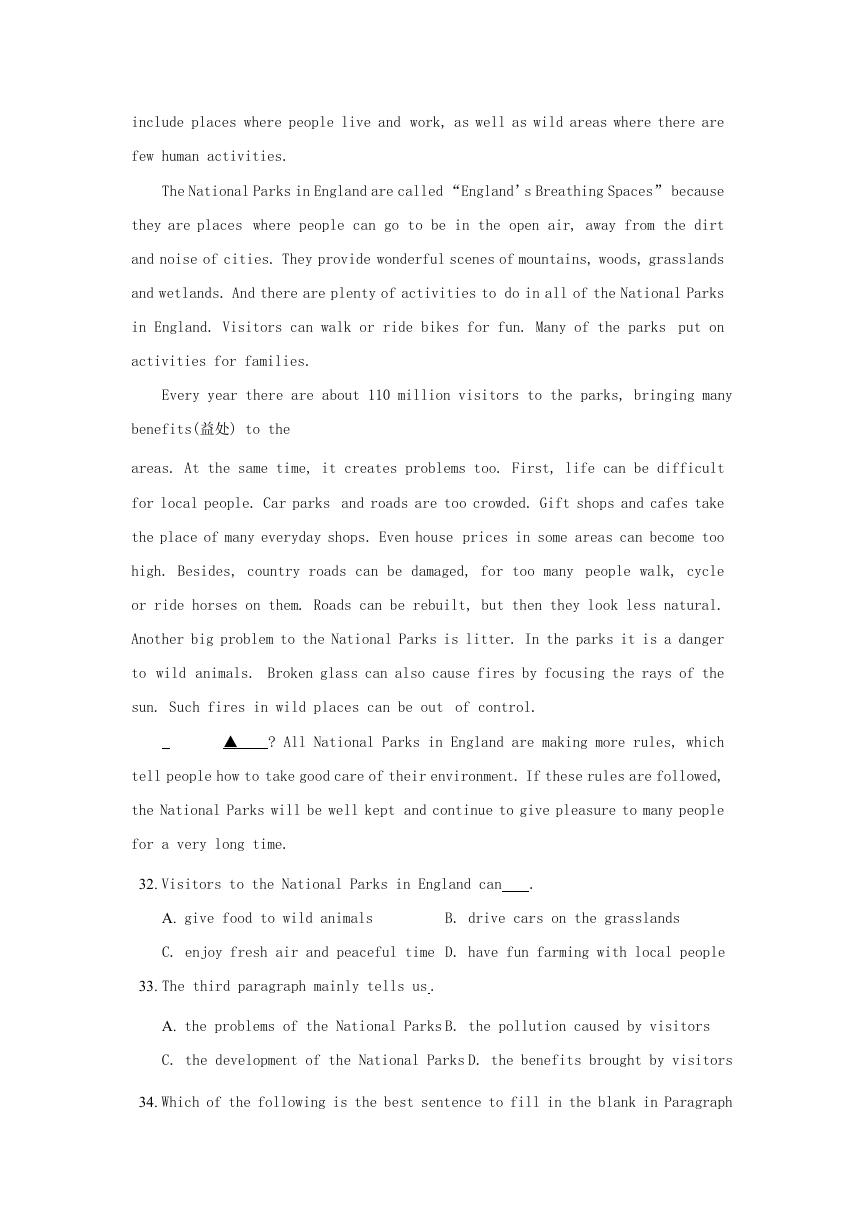
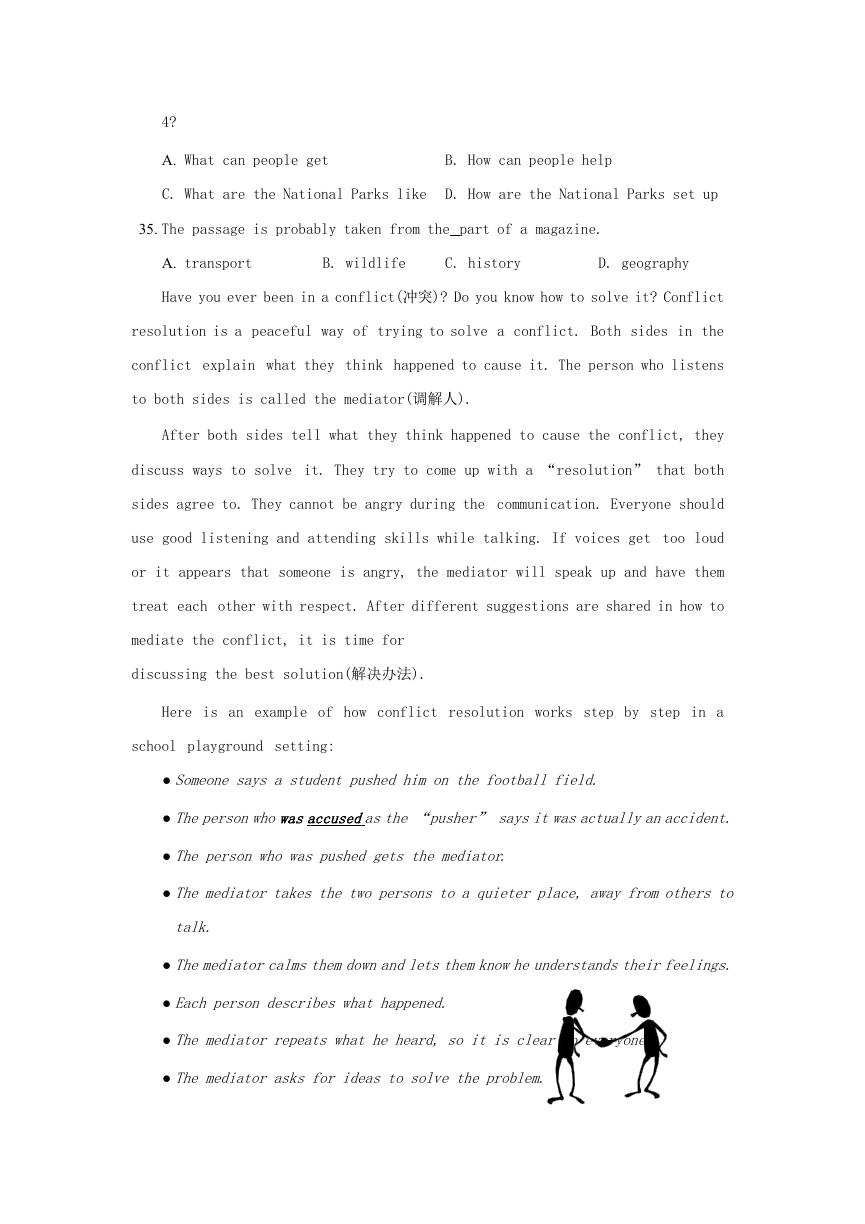
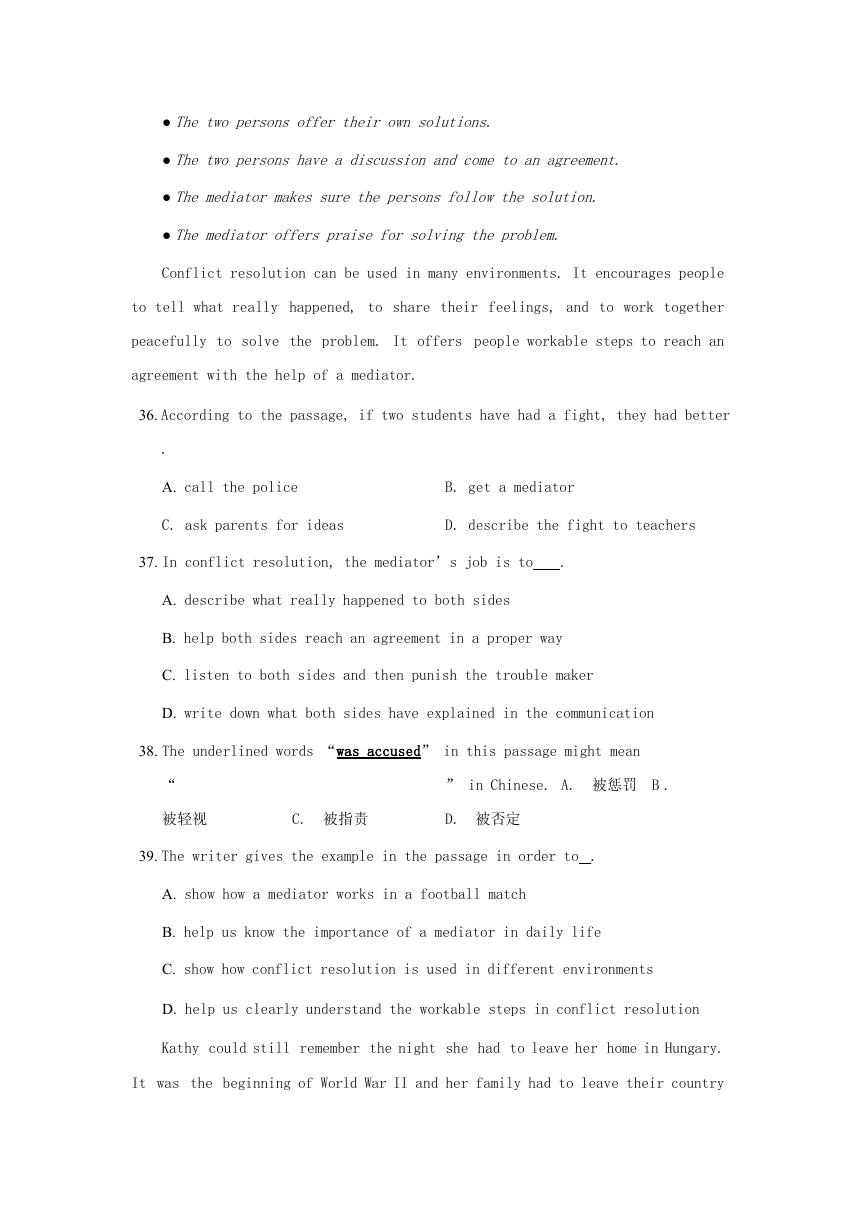
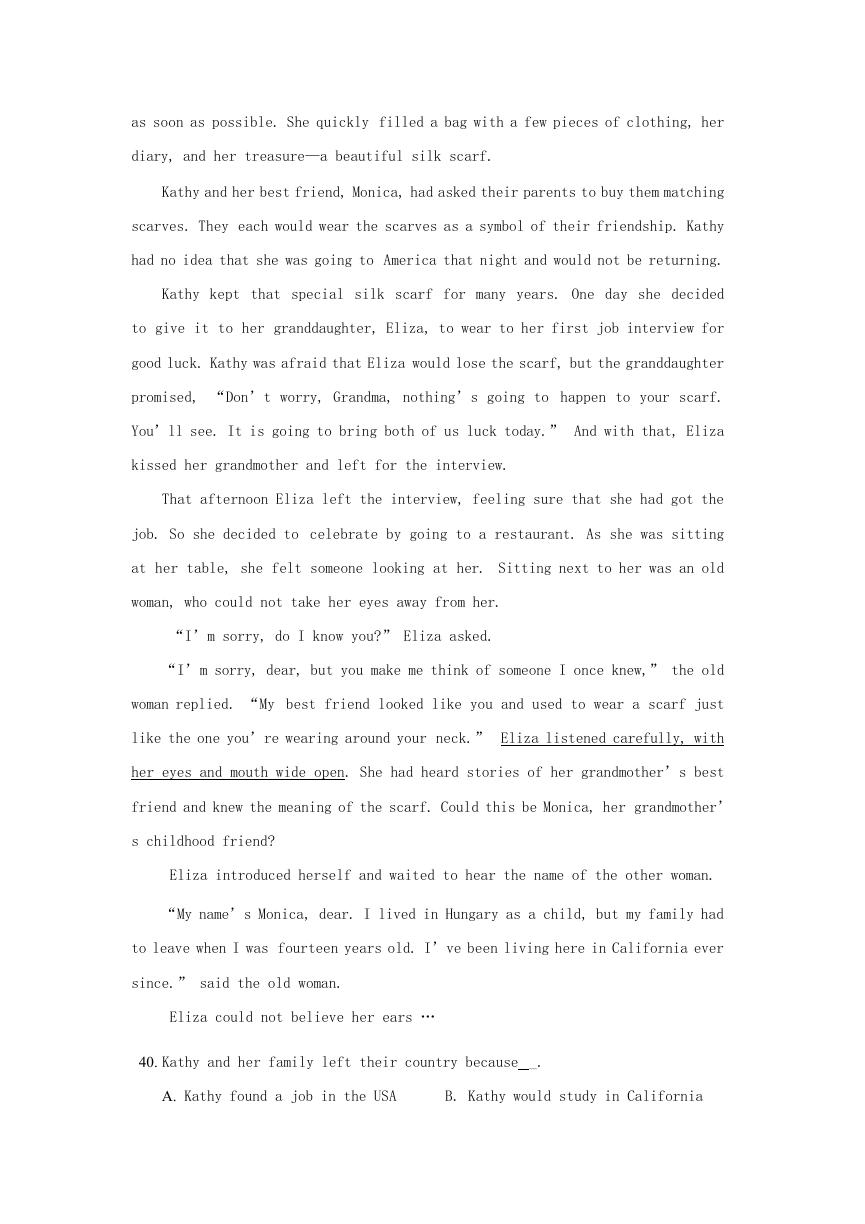








 2023年江西萍乡中考道德与法治真题及答案.doc
2023年江西萍乡中考道德与法治真题及答案.doc 2012年重庆南川中考生物真题及答案.doc
2012年重庆南川中考生物真题及答案.doc 2013年江西师范大学地理学综合及文艺理论基础考研真题.doc
2013年江西师范大学地理学综合及文艺理论基础考研真题.doc 2020年四川甘孜小升初语文真题及答案I卷.doc
2020年四川甘孜小升初语文真题及答案I卷.doc 2020年注册岩土工程师专业基础考试真题及答案.doc
2020年注册岩土工程师专业基础考试真题及答案.doc 2023-2024学年福建省厦门市九年级上学期数学月考试题及答案.doc
2023-2024学年福建省厦门市九年级上学期数学月考试题及答案.doc 2021-2022学年辽宁省沈阳市大东区九年级上学期语文期末试题及答案.doc
2021-2022学年辽宁省沈阳市大东区九年级上学期语文期末试题及答案.doc 2022-2023学年北京东城区初三第一学期物理期末试卷及答案.doc
2022-2023学年北京东城区初三第一学期物理期末试卷及答案.doc 2018上半年江西教师资格初中地理学科知识与教学能力真题及答案.doc
2018上半年江西教师资格初中地理学科知识与教学能力真题及答案.doc 2012年河北国家公务员申论考试真题及答案-省级.doc
2012年河北国家公务员申论考试真题及答案-省级.doc 2020-2021学年江苏省扬州市江都区邵樊片九年级上学期数学第一次质量检测试题及答案.doc
2020-2021学年江苏省扬州市江都区邵樊片九年级上学期数学第一次质量检测试题及答案.doc 2022下半年黑龙江教师资格证中学综合素质真题及答案.doc
2022下半年黑龙江教师资格证中学综合素质真题及答案.doc